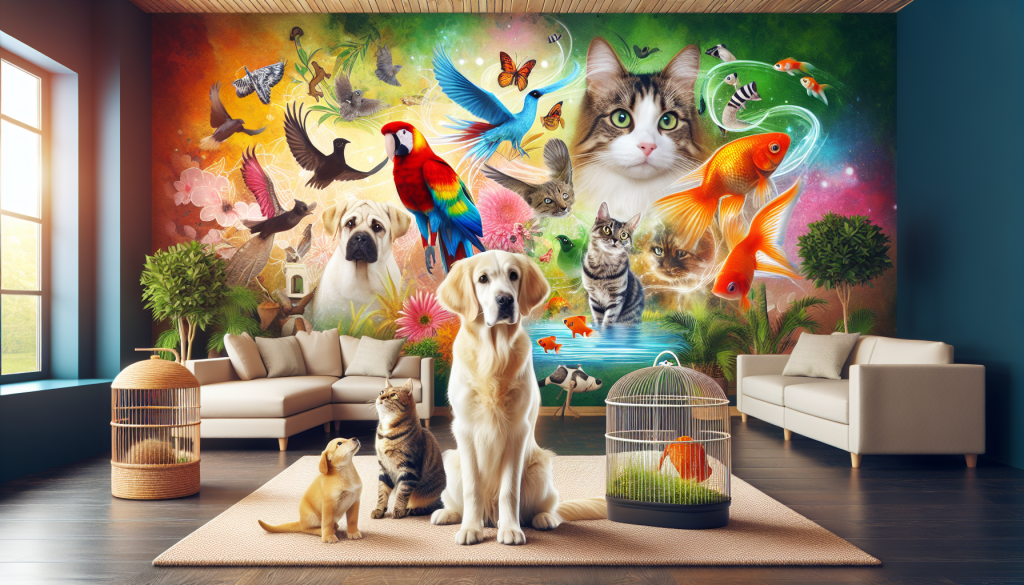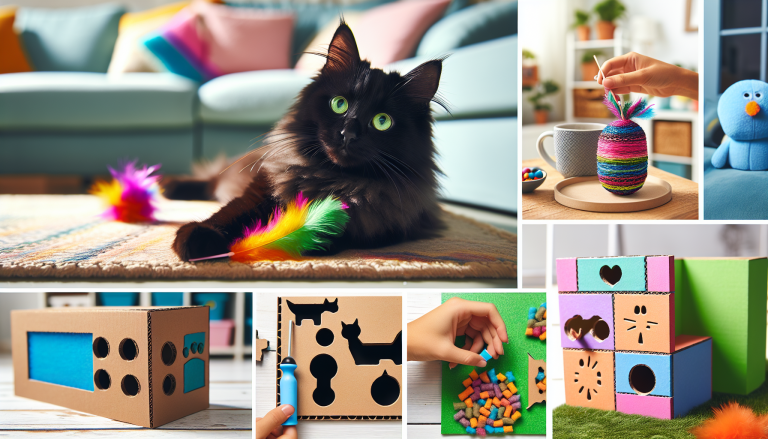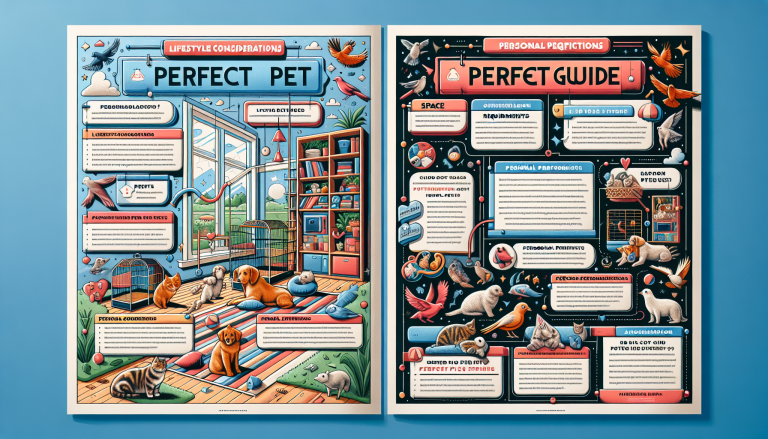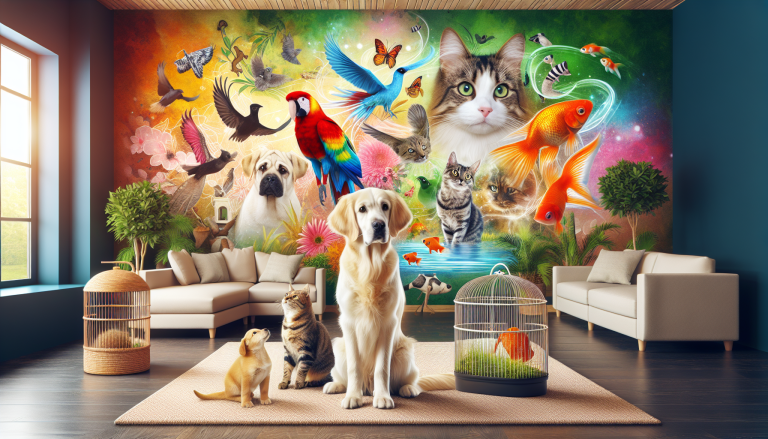Choosing the perfect pet to welcome into your life can be an exciting yet overwhelming decision, as you consider factors such as your lifestyle, living situation, and personal preferences. With so many adorable options out there, it can be difficult to know where to start. That’s why this article will guide you on how to choose the right pet for your lifestyle, offering valuable insights and tips to ensure a furry friend who will fit seamlessly into your daily routine and bring joy to your life.
Table of Contents
ToggleConsider Your Lifestyle
Assess Your Daily Routine
When choosing a pet, one of the first things you should consider is your daily routine. Think about how much time you spend at work or school and what your typical schedule looks like. This will help you determine how much time you can realistically commit to taking care of a pet. If you have a busy schedule with long hours away from home, a pet that requires minimal attention and care might be a better fit for you.
Evaluate Your Free Time
In addition to your daily routine, it’s important to evaluate how much free time you have available. Some pets, like dogs, require a lot of time and attention. They need to be walked, played with, and given plenty of exercise. If you have a busy social life or hobbies that take up a significant amount of your free time, a low-maintenance pet might be a better fit for you.
Consider Your Travel Frequency
Another factor to consider when choosing a pet is how often you travel. If you frequently go on trips or have a job that requires you to be away from home for extended periods, it’s important to choose a pet that can handle your absence. Some pets, like cats or small mammals, can be left alone for longer periods of time with the proper care and provisions. On the other hand, dogs and birds often require constant companionship and may not be the best choice for frequent travelers.
Assess Your Physical Activity Level
Your own physical activity level is also an important consideration when choosing a pet. If you enjoy staying active and have the time and energy for daily exercise, a dog might be a great companion for you. Dogs require regular exercise and mental stimulation to thrive. However, if you prefer a more low-key lifestyle or have physical limitations that make exercising difficult, a cat or small mammal might be a better match for your lifestyle.
Research Different Pet Types
Learn About Dogs
Dogs are one of the most popular pets, and for good reason. They are loyal, loving, and can provide great companionship. However, they also require a lot of time, attention, and training. It’s important to research different dog breeds to find one that matches your lifestyle and preferences. Some breeds are more active and require plenty of exercise, while others are more relaxed and are content with shorter walks. Additionally, consider the size and energy level of the dog breed you are interested in to ensure it is suitable for your living environment.
Explore Cats as Pets
Cats are known for their independence and low-maintenance nature. They are great companions for people with busy lifestyles or those who prefer a more laid-back pet. Cats are generally self-sufficient when it comes to grooming, and they are litter-trained, which makes them relatively easy to care for. However, it’s important to remember that cats still require attention and social interaction. Spend some time researching different cat breeds to find one that matches your personality and living situation.
Consider Birds as Companions
Birds can make wonderful companions for those who are looking for a pet that is both entertaining and engaging. They come in a variety of sizes and colors, each with unique traits and personalities. Birds require social interaction and mental stimulation, so be sure to dedicate time each day to engage with your feathered friend. It’s important to research the specific needs of the bird species you are interested in, as they can vary greatly in terms of care requirements and lifespan.
Learn About Fish and Aquariums
For those who prefer a pet that is visually appealing and requires minimal interaction, fish can be a great choice. Fishkeeping can be a relaxing and rewarding hobby, and owning an aquarium can add a beautiful touch to your home. However, it’s important to understand that fish still require care and maintenance. You’ll need to regularly clean the tank, monitor water conditions, and ensure that the fish are fed a proper diet. Additionally, research different types of fish to determine which ones are suitable for beginners and compatible with the size of your tank.
Consider Small Mammals as Pets
Small mammals such as hamsters, guinea pigs, or rabbits can be a great option for those who want a pet that is relatively low-maintenance but still provides companionship. These animals require a smaller living space compared to dogs or cats, making them suitable for smaller homes or apartments. However, keep in mind that small mammals still require regular care, including feeding, cleaning their habitat, and providing mental and physical stimulation. Research different small mammal species to find one that matches your preferences and lifestyle.
Explore Reptiles and Amphibians
Reptiles and amphibians can be fascinating pets for those who are interested in unique and exotic animals. These animals have specific care requirements that need to be met to ensure their well-being. They require specialized enclosures with the correct temperature and humidity levels, as well as a proper diet. Reptiles and amphibians may not be suitable for everyone, as they typically require more effort and knowledge to care for properly. It’s important to research different species and consult with experts to determine if you are willing and able to provide the necessary care and environment.
Evaluate Space Requirements
Consider Indoor vs. Outdoor Pets
When considering a pet, it’s important to think about whether you have the space for an indoor or outdoor pet. Some pets, like cats or small mammals, can live happily indoors and don’t require access to a backyard. Others, like dogs or certain types of birds, may need access to outdoor spaces to exercise and explore. Assess your living situation and the available space you have to determine which type of pet is more suitable for you.
Assess Space Availability for Large Pets
If you’re considering a larger pet, such as a dog or a large bird, it’s crucial to evaluate the space available in your home. These animals require ample room to move around comfortably. Dogs need enough space to play and exercise, both indoors and outdoors. Large birds need spacious cages or aviaries to spread their wings and explore. Make sure you have enough space to accommodate the needs of a larger pet and provide them with a safe and comfortable environment.
Consider Small Pets in Small Spaces
Living in a small space, such as an apartment or a small house, doesn’t necessarily mean you can’t have a pet. There are many small pets that are well-suited for smaller living spaces. Small mammals like hamsters or guinea pigs can be easily housed in cages, and their space requirements are relatively minimal. Cats can also adapt well to smaller spaces, as long as they have ample opportunities for exercise and play. With proper planning and care, it is possible to have a pet even in a smaller living environment.
Analyze Financial Commitments
Initial Pet Adoption or Purchase Cost
Owning a pet comes with financial responsibilities, and it’s important to factor in the initial cost of adopting or purchasing a pet. Adoption fees for animals from shelters or rescue organizations can vary, often including vaccinations, spaying/neutering, and microchipping. If you’re considering purchasing a pet from a breeder, the cost can vary significantly depending on the breed and lineage. Research the average costs associated with adopting or purchasing different types of pets to determine what fits within your budget.
Calculate Ongoing Expenses
In addition to the initial cost, it’s crucial to consider the ongoing expenses associated with owning a pet. This includes food, toys, bedding, grooming supplies, and other necessities. Some pets, like dogs or larger birds, may have higher food and supply costs due to their size and dietary needs. Vet bills, including regular check-ups, vaccinations, and potential medical treatments, should also be factored into your financial plan. Calculate the estimated monthly costs associated with different types of pets to ensure you can comfortably afford their care.
Consider Veterinary Costs
Pets, like humans, require regular veterinary care to stay healthy. Routine check-ups, vaccinations, and preventive medication are essential to ensure your pet’s well-being. Additionally, unexpected medical issues or emergencies can arise, requiring additional veterinary care. It’s important to research the average veterinary costs in your area and factor them into your budget. Some pet insurance plans can help mitigate these expenses, so it may be worth exploring different insurance options for your chosen pet as well.
Evaluate Potential Pet Insurance
Pet insurance can provide financial assistance in the event of unexpected medical expenses for your pet. It can help cover the cost of veterinary care, surgeries, or medication, depending on the policy you choose. Before deciding on the type of pet insurance to purchase, carefully read and understand the terms, exclusions, and limitations of the insurance policy. Determine if pet insurance is a valuable investment for your chosen pet and include the cost of insurance premiums in your financial assessment.
Assess Allergies and Sensitivities
Consider Pet Allergies
Before bringing a pet into your home, it’s essential to consider whether you or anyone in your household have pet allergies. Pet allergies can cause a wide range of symptoms, including sneezing, itchy eyes, and respiratory issues. If you or a family member have allergies, it’s important to research hypoallergenic pet options or consult with an allergist to determine which pets are less likely to trigger allergies. Remember that even hypoallergenic pets may still cause allergic reactions in some individuals, so thorough research and consideration are necessary.
Evaluate Sensitivities to Fur or Dander
Even if there are no known pet allergies in your household, it’s still important to consider sensitivities to fur or dander. Some individuals may be more sensitive to pet hair or dander, which can cause discomfort or irritation. Breeds with shorter hair or those that shed less may be more suitable for individuals with sensitivities. Regular grooming and cleaning routines can also help reduce the presence of pet hair and dander in your home. Take into account any sensitivities when researching different types of pets to ensure a comfortable living environment for everyone in your household.
Explore Hypoallergenic Pet Options
If you or someone in your household has pet allergies, considering hypoallergenic pet options is crucial. Hypoallergenic pets are less likely to cause allergic reactions in individuals with sensitivities to pet dander. Some hypoallergenic dog breeds, such as poodles or Bichon Frises, have hair instead of fur and shed less. Certain cat breeds, like the Balinese or Siberian, produce fewer allergenic proteins. However, it’s important to note that individual reactions can still vary, and it’s recommended to spend time with the specific breed to determine if there is any allergic reaction before bringing them into your home.
Determine Level of Interaction
Consider Social Needs of Different Pets
When choosing a pet, it’s important to consider the level of social interaction they require. Pets like dogs thrive on human companionship and need regular social interaction. They enjoy being part of the family and being involved in daily activities. Cats, on the other hand, are often more independent and may not require as much social interaction. Birds require regular interaction and mental stimulation to prevent boredom, while fish are generally low in social needs. Consider your own desire for interaction and choose a pet that matches your social needs.
Evaluate Time Required for Bonding
Building a bond with your pet takes time and effort. Some pets, like dogs, may bond quickly and easily, while others, like cats or birds, may take more time to warm up to their owners. Consider how much time you have available to dedicate to bonding with your pet. If you’re looking for a pet that will become a close companion and enjoy spending time with you, a dog may be the best choice. Alternatively, if you prefer a more independent pet that requires less immediate bonding, a cat or small mammal may be a better fit.
Assess the Need for Play and Exercise
Play and exercise are important for the physical and mental well-being of pets. Dogs require regular exercise and playtime to expend energy and stay healthy. Cats also benefit from play sessions that mimic hunting behaviors. Birds require mental stimulation and interactive play to prevent boredom. While not all pets require the same level of play and exercise, it’s important to consider your own ability and willingness to provide these activities. Assess your lifestyle and choose a pet that matches your commitment to play and exercise.
Consider Lifespan and Commitment
Research Different Lifespans
Pets have different lifespans, ranging from just a few years to several decades. It’s important to consider the lifespan of a potential pet and the commitment it entails. Dogs, on average, live around 10 to 15 years, while cats can live well into their late teens or early twenties. Some bird species, like parrots, can live for over 50 years. Consider your long-term plans and ensure that you can provide the necessary care for your pet throughout its lifespan. Remember, owning a pet is a long-term commitment.
Evaluate Long-Term Commitment
Owning a pet is a long-term commitment that requires time, effort, and resources. Before bringing a pet into your life, evaluate your readiness to provide care for the duration of its life. Pets rely on their owners for their physical and emotional needs, and they form deep attachments to their human caregivers. Determine if you are ready and willing to commit to a long-term relationship with a pet, including potential lifestyle adjustments and financial responsibilities.
Plan for Future Life Changes
It’s important to consider how your future life changes may affect your ability to care for a pet. Are you planning to start a family, change jobs, or relocate in the near future? These factors can impact your pet’s well-being and happiness. Before getting a pet, evaluate any potential life changes and determine if you can still provide the necessary care and attention they require. Planning ahead will help ensure that you can adapt to these changes while still providing a loving and stable environment for your pet.
Assess Compatibility with Family and Other Pets
Evaluate Compatibility with Children
If you have children or are planning to have children in the future, it’s crucial to consider a pet’s compatibility with children. Some pets, like dogs or certain cat breeds, are generally more tolerant and patient with children. Others may be easily overwhelmed or have specific personality traits that make them less suitable for households with young children. Research different pet breeds and species known for their compatibility with children and choose a pet that can coexist safely and happily with your family.
Consider Other Pets in the Household
If you already have other pets in your household, it’s important to consider their compatibility with a new pet. Not all pets get along well with others, and introducing a new pet can disrupt the existing dynamics. Take into account the temperament and behavior of your current pets and research how they may interact with the potential new addition. Also, consider the needs and preferences of your current pets to ensure their well-being is not compromised by the introduction of a new pet. Proper introductions and gradual acclimation can help increase the chances of a successful and harmonious multi-pet household.
Understand Training and Care Requirements
Explore Training Needs for Dogs
Dogs require training to ensure they are well-behaved, obedient, and safe. If you’re considering getting a dog, research the specific training needs associated with different breeds. Some breeds are more stubborn or independent and may require more consistent and patient training. Training helps establish boundaries, addresses behavioral issues, and strengthens the bond between you and your dog. Assess your ability and willingness to invest time and effort into training a dog, or consider working with a professional trainer if needed.
Learn About Litter Training for Cats
Cats are naturally inclined to use a litter box for their bathroom needs. However, proper litter training is still necessary to ensure they use the designated area consistently. If you’re considering getting a cat, familiarize yourself with the basics of litter training. Choose the right litter box and litter type, and establish a routine for cleaning and maintaining the litter box. Understanding litter training will help ensure a hygienic and stress-free environment for both you and your feline companion.
Consider Training and Care for Birds
Birds, although small in size, still require training and care. Basic training, such as hand-taming and teaching simple commands, can help strengthen the bond between you and your bird. Birds also need mental stimulation and environmental enrichment to prevent boredom and promote healthy behaviors. Research the specific training and care needs of the bird species you are interested in and assess your ability to provide the necessary time and attention.
Learn About Tank Maintenance for Fish
Owning fish requires more than just providing them with food and water. Fish tanks need regular maintenance to ensure the health and well-being of the aquatic inhabitants. Tasks such as cleaning the tank, monitoring water parameters, and performing water changes are necessary for maintaining a stable and clean environment. Research the specific care requirements for different types of fish and aquarium setups to ensure you can properly provide for their needs.
Explore Care for Small Mammals
Small mammals like hamsters, guinea pigs, or rabbits require specific care to thrive. They require appropriate housing, a proper diet, and mental stimulation. Each species has unique needs and preferences when it comes to their living environment, feeding, and exercise. Research the specific care requirements for the small mammal species you are interested in and ensure you can provide the necessary care and attention.
Consider Maintenance for Reptiles and Amphibians
Reptiles and amphibians have specific care requirements that need to be met to ensure their well-being. These can include providing the appropriate temperature and humidity levels, creating a suitable habitat, and feeding the correct diet. Additionally, cleaning and maintaining their enclosures are essential for their health and hygiene. Research the specific care needs of the reptile or amphibian species you are interested in, including their dietary and environmental requirements, to ensure you can provide the necessary care.
Consider Adoption or Purchase
Evaluate Local Animal Shelters
If you’re considering getting a pet, adopting from a local animal shelter or rescue organization can be a wonderful choice. Animal shelters often have a variety of pets in need of loving homes, including dogs, cats, small mammals, and sometimes even birds or reptiles. By adopting from a shelter, you give a homeless pet a second chance at a happy life. Additionally, adoption fees are typically more affordable than purchasing a pet, and many animals are already spayed/neutered and vaccinated.
Research Reputable Breeders
If you have a specific breed or type of pet in mind, researching reputable breeders can be a good option. Responsible breeders prioritize the health and well-being of their animals and carefully select breeding pairs to produce healthy and well-tempered offspring. When choosing a breeder, look for someone who is knowledgeable about the breed, provides proper care for their animals, and is transparent about the breeding process. Visit the breeder’s facility if possible and ensure they prioritize the welfare of their animals above all else.
Consider Pet Stores
Pet stores are another option for obtaining a pet, but it’s important to approach them with caution. While some pet stores prioritize the well-being of their animals and source from reputable breeders, others may not provide proper care or ethical breeding practices. Before purchasing a pet from a pet store, research the store’s reputation and visit to assess the conditions in which the animals are kept. Ensure that the store is transparent about the origins of their pets and their commitment to animal welfare.
Explore Adoption Fairs and Events
Adoption fairs and events are often held by local animal shelters or rescue organizations to showcase adoptable pets. These events provide an opportunity to meet different animals and learn more about their personalities and care requirements. Many adoption fairs offer discounted adoption fees and may involve additional perks such as initial veterinary care or behavioral assessments. Attending adoption fairs and events can be a great way to find the perfect pet while supporting local rescue efforts.
In conclusion, choosing the right pet for your lifestyle requires careful consideration of various factors. Assessing your daily routine, evaluating your free time, and considering your travel frequency are essential to ensure that you can provide the necessary time and attention to a pet. Researching different pet types, evaluating space requirements, and analyzing financial commitments will help you make an informed decision about the type of pet that suits your living environment and budget. Assessing allergies and sensitivities, determining the desired level of interaction, and considering lifespan and commitment will ensure a compatible and fulfilling relationship with your chosen pet. Finally, understanding training and care requirements, considering adoption or purchase, and assessing compatibility with family and other pets will complete your journey to finding the perfect pet for your lifestyle.








